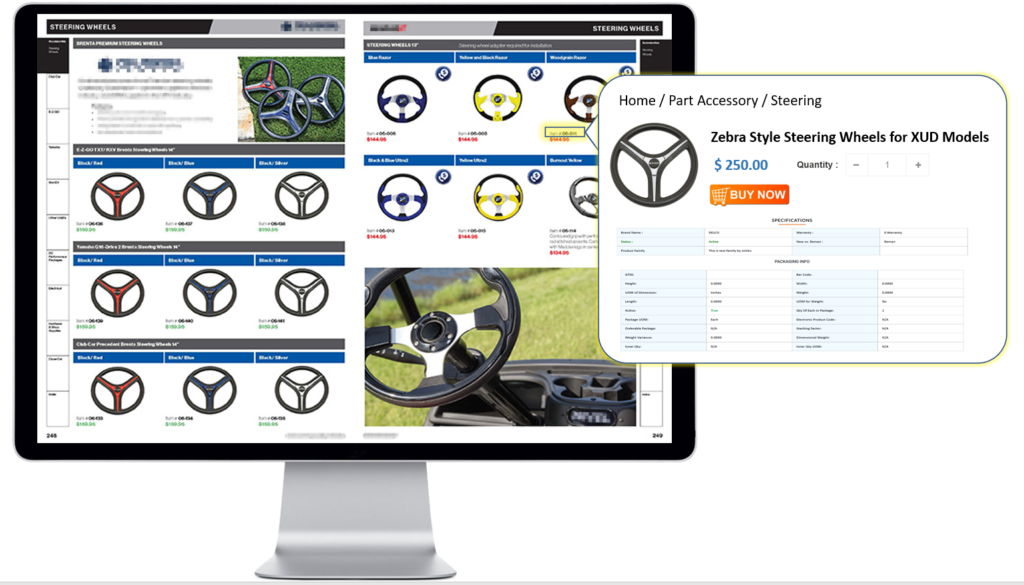Automotive parts catalogs are critical for the resellers and end-users to determine parts fitment. These catalogs tend to be highly technical with product specifications: This helps buyers make informed decisions. The product catalogs were often printed in bulk and distributed. With the ongoing revolution in the automotive aftermarket, there is a growing demand for EPCs (Electronic Product Catalog) which can be accessible by customers anywhere, anytime.
Catalog mailings have been on the increase since 2015. It is also worth noting that customers are enthusiastic about receiving EPCs. The response rates from catalogs have increased by as much as 170% from 2004 to 2018 - Print Power from a study published in Harvard Business Review in 2020. Hence, manufacturers, and resellers are transitioning to digitize and distribute data effectively.
How did this digital revolution affect our client?
Our client is a tier-1 global aftermarket manufacturer, distributor and seller of speciality and heavy-duty vehicle parts and accessories. With access to more than 100,000 parts and accessories, they are one of the largest suppliers of aftermarket part industries in North America
● Uncategorized product data were available in excel sheets in huge volumes. It was difficult to find a part-fitment, spare or accessories with ease. This lowered their chances of upselling and cross-selling parts to their customers.
● Making changes to specifications for better and newer products was infrequent, tedious, and time-consuming. Ineffective data management led to the loss of revenue.
● Older PDF catalog was outdated and failed to engage the customers visually. Low-quality images and design made the PDF less appealing.
How we resolved their challenges
With more than two decades in the automotive and related industries, we understood the challenges our client faced and offered to:
1. Leverage their product data with our PMT tool.
2. Design & Develop Electronic Product Catalog (EPC)
3. Publish the EPC
4. Provide the printable version of EPC, for offline marketing
You can read more about our Cataloging services here
Deep dive into the process:
1. Leverage their product data with our PMT tool.
● Data cleaning: Once the input data in excel was received from the client, our aftermarket experts processed the data manually to ensure that the given product information in the excel sheet is dependable, usable, and consistent using macros.

● Image Processing: Converted the low-resolution images to high-quality images, removed the backgrounds and set appropriate backgrounds for heavy-duty products and incorporated the company watermark.

● Data management: The leveraged data was then Imported into PMT (Product Management Tool) to organize and manage data more effectively like defining taxonomy, updating products with descriptions, pricing information, accurate specifications, and ensuring adherence to data standards. Product images and data were associated through the Asset vault (Digital asset management system). Appropriate component scan codes were incorporated for users to view more details from the EPC. The data was then automated and imported directly into the newly designed EPC later based on the product taxonomy.
Overall, the data process ensured that both corporate users and consumers found precisely ‘what they were looking for’ with ease. Updates made to the product information could be pushed into the EPC seamlessly.
2. Design & Develop Electronic Product Catalog (EPC)
Design experts with aftermarket domain knowledge created an appealing theme and layout for the EPC which would help users/customers to visualize and imagine product usage experiences. This would increase customers’ involvement, and positively influence their preferences and sales. All the product data and its associated product images were imported directly into the EPC through automation available with PMT.
3. Publish the E-Catalog:
After rigorous testing, the final e-Catalog was published. This e-catalog can be easily shared via emails and social media for creating brand awareness and lowering marketing costs.
4. Printable PDFs:
Since offline marketing is more targeted, we have provided the capability to download the catalog data based on their target audience requirement and print them directly for effective use.
Our client’s success is our success too!
Our clients' new e-Catalog is being accessed, shared and distributed with ease, making a positive impact in their purchasing decisions.

To find out more about our PDF Catalog



